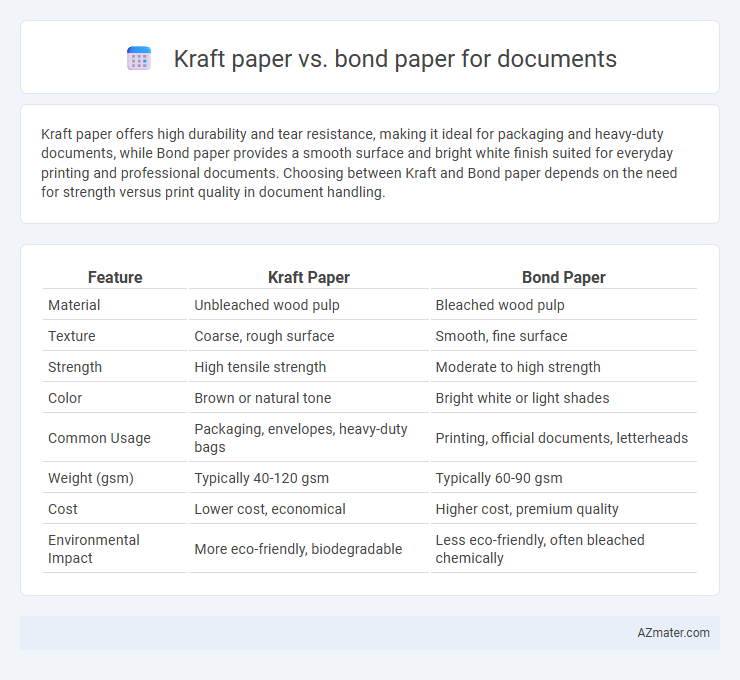Kraft paper offers high durability and tear resistance, making it ideal for packaging and heavy-duty documents, while Bond paper provides a smooth surface and bright white finish suited for everyday printing and professional documents. Choosing between Kraft and Bond paper depends on the need for strength versus print quality in document handling.
Table of Comparison
| Feature | Kraft Paper | Bond Paper |
|---|---|---|
| Material | Unbleached wood pulp | Bleached wood pulp |
| Texture | Coarse, rough surface | Smooth, fine surface |
| Strength | High tensile strength | Moderate to high strength |
| Color | Brown or natural tone | Bright white or light shades |
| Common Usage | Packaging, envelopes, heavy-duty bags | Printing, official documents, letterheads |
| Weight (gsm) | Typically 40-120 gsm | Typically 60-90 gsm |
| Cost | Lower cost, economical | Higher cost, premium quality |
| Environmental Impact | More eco-friendly, biodegradable | Less eco-friendly, often bleached chemically |
Introduction to Kraft Paper and Bond Paper
Kraft paper is a durable, coarse paper made from wood pulp through the kraft process, known for its strength and eco-friendly properties, commonly used for packaging and wrapping. Bond paper, typically made from wood pulp with a smoother finish and higher brightness, is designed for professional documents, letterheads, and office printing. Understanding the distinct characteristics of Kraft paper and Bond paper helps in selecting the right material for durability versus presentation quality in document needs.
Key Differences Between Kraft Paper and Bond Paper
Kraft paper is a coarse, brown paper made from wood pulp, known for its high durability, tear resistance, and eco-friendliness, commonly used for packaging and wrapping. Bond paper, typically white and smooth, is made from high-quality cotton or alpha cellulose fibers, favored for printing, official documents, and letterheads due to its professional appearance and superior printability. Key differences include texture--coarse versus smooth, color--brown versus white, and usage--packaging versus formal document printing.
Composition and Manufacturing Process
Kraft paper is made from wood pulp using the kraft process, which involves chemical treatment to remove lignin, resulting in strong, coarse fibers ideal for packaging and industrial use. Bond paper is produced from bleached wood pulp through a mechanical and chemical process that ensures a smoother, lighter surface suitable for printing and writing. The difference in fiber treatment and bleaching determines kraft paper's durability and rough texture, while bond paper offers a refined finish for document clarity.
Durability and Strength Comparison
Kraft paper is renowned for its superior durability and high tensile strength due to its unbleached, natural fibers, making it ideal for heavy-duty packaging and long-lasting documents. Bond paper, while smoother and more refined, offers moderate strength suited for everyday printing and writing tasks but is less resistant to tearing and environmental wear. Choosing kraft paper ensures enhanced toughness and longevity, whereas bond paper prioritizes print quality over ruggedness.
Print Quality and Ink Absorption
Kraft paper features a coarse surface with high ink absorption, resulting in bold and vibrant prints but less sharp detail, making it ideal for rustic or eco-friendly designs. Bond paper offers a smooth texture with moderate ink absorption, delivering crisp, clear text and fine image details, preferred for professional documents and high-quality printing. Selecting between Kraft and Bond paper depends on the needed print clarity and the desired aesthetic impact of the document.
Environmental Impact and Sustainability
Kraft paper, produced from wood pulp using minimal processing, is highly biodegradable and often comes from recycled materials, making it an eco-friendly choice for documents. Bond paper, typically made from refined wood pulp with chemical bleaching, has a higher environmental footprint due to energy-intensive processing and lower recyclability. Choosing kraft paper reduces waste and supports sustainable forestry, aligning with environmentally responsible document practices.
Cost Analysis: Kraft Paper vs Bond Paper
Kraft paper is generally more cost-effective than bond paper due to its lower manufacturing expenses and use of recycled fibers, making it ideal for bulk packaging and rough documentation needs. Bond paper, while pricier, offers superior smoothness and brightness, enhancing print quality and durability for official documents and presentations. Choosing between kraft and bond paper depends on budget constraints and the required print finish, with kraft providing economic value and bond ensuring professional appearance.
Best Uses for Kraft Paper in Documentation
Kraft paper is ideal for packaging, wrapping, and archival documentation due to its durability and tear resistance, making it perfect for protecting documents during shipping or long-term storage. Unlike bond paper, which is optimized for printing and everyday office use, kraft paper's coarse texture and strength lend themselves to eco-friendly, heavy-duty applications such as industrial labeling and environmental-friendly document folders. Its natural brown color and high fiber content also contribute to enhanced recyclability and sustainability in documentation practices.
Advantages of Bond Paper for Official Documents
Bond paper offers superior durability and a smooth surface ideal for high-quality printing, making it the preferred choice for official documents requiring longevity and professional appearance. Its resistance to ink bleed-through ensures crisp, clear text, which is essential for legal, financial, and governmental paperwork. The lightweight nature of bond paper also facilitates easy handling, filing, and mailing without compromising document integrity.
Making the Right Choice for Your Document Needs
Kraft paper provides durability and a distinctive, rustic appearance ideal for packaging and eco-friendly document presentations, while bond paper offers smooth texture and high brightness suited for professional documents and everyday printing. Choosing the right paper depends on factors such as document purpose, desired aesthetic, and printer compatibility. For official reports or resumes, bond paper ensures clarity and professionalism, whereas kraft paper excels in creative projects or eco-conscious branding.

Infographic: Kraft paper vs Bond paper for Document
 azmater.com
azmater.com